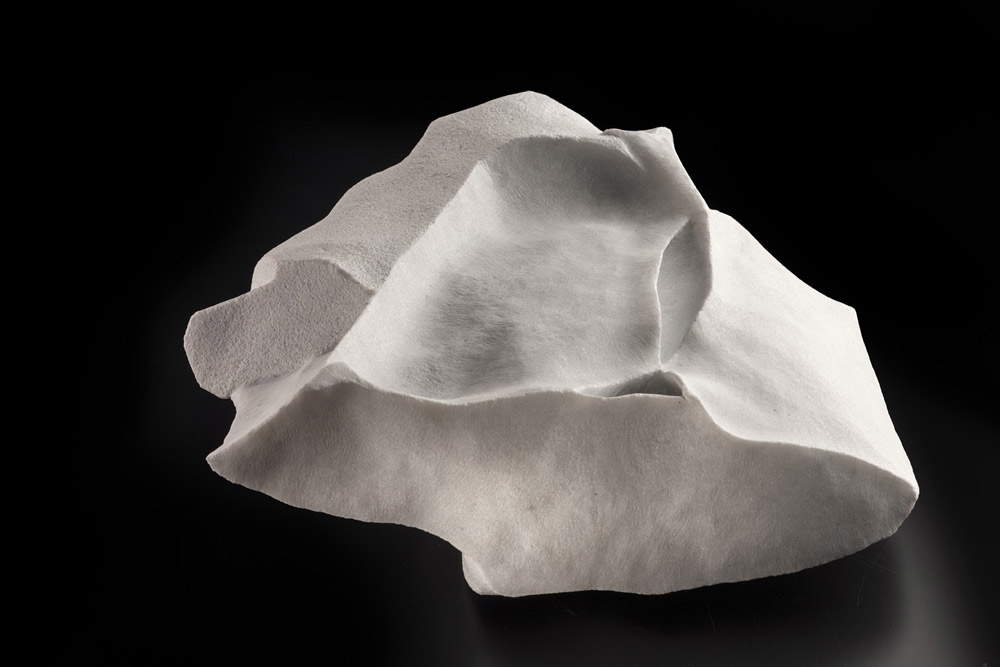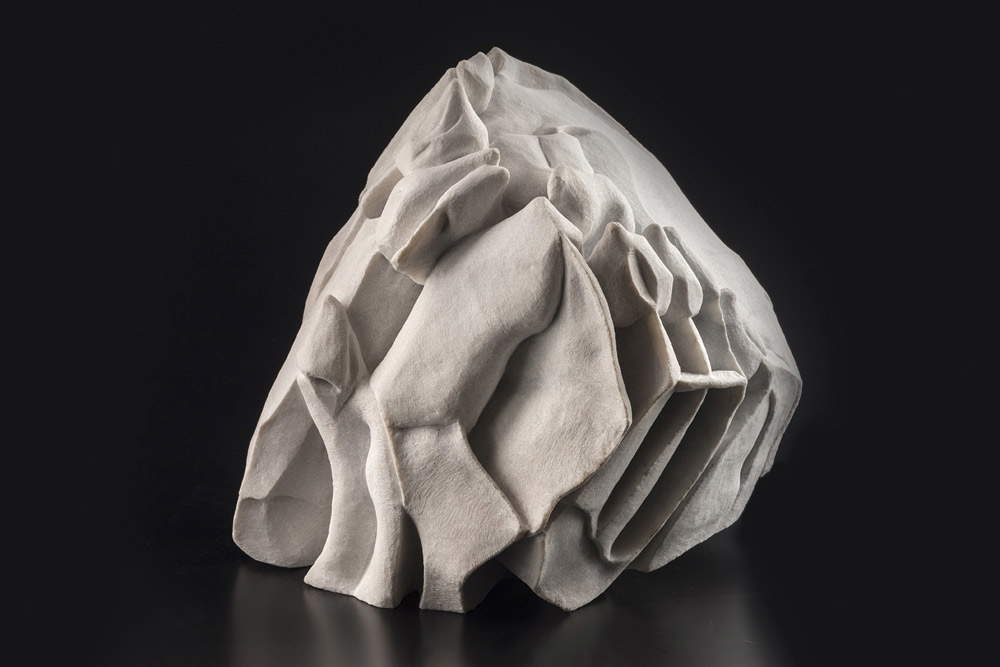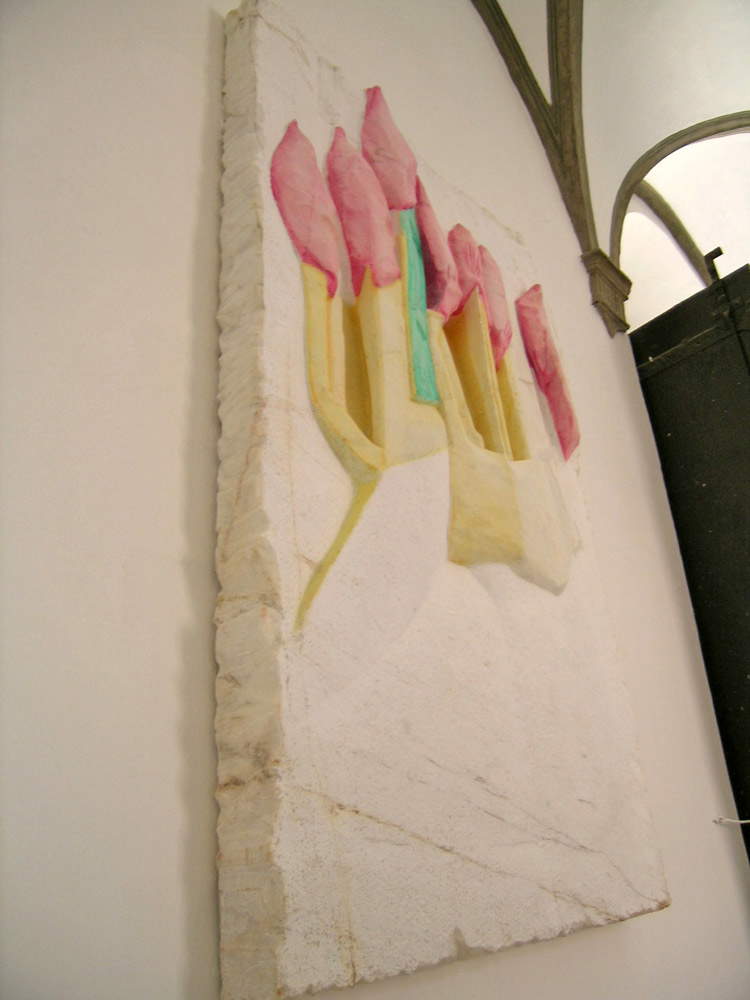Federico Fusj (Siena, 1967) is an eclectic contemporary artist, an experimenter constantly searching for new possibilities and new languages to merge even seemingly distant artistic experiences. For example, his is the idea of a “radio art,” which he considers a discipline similar to painting or sculpture. Educated at the Art Institute of Siena and the Brera Academy of Fine Arts, Fusj studied with Alik Cavaliere, Andrea Cascella and Luciano Fabro, and has exhibited in national and international contexts (e.g., at Jan Fabre’s Troubleyn Laboratorium in Antwerp, Museum SMAK in Ghent, the ninth Sonsbeek in Arnhem, and the seventh Havana Biennial). He is also founder of the radio station Radioarte and the art production label Inner Room. We caught up with him to hear about his very special research. Interview by Ilaria Baratta.
 |
| Federico Fusj, Ambiente@Troubleyn.be (2016; pigments on paper, sound, brass; Antwerp, Troubleyn Museum) |
IB. In 2016, he organized a cultural trek to place the white onyx sculpture Fonte Y accompanied by a Peshitta, a Syriac version of the New Testament, on the SantOnofrio grounds. The initiative was related to Christian monasticism: what did this initiative mean to you? How did the idea come to you? To what extent are your works related to the sacred?
FF. The event was organized by theAcademia di Belle Arti dellAquila, conceived by its director, Professor Marco Brandizzi, and my area curated by Professor Enzo de Leonibus. It was to identify paths of art and spirituality in the hermitages ofAbruzzo, bringing to light this great tradition that predates Celestine V. In this specific case, I organized this cultural trek because I intended to start from the reality of the area, namely the hermitage of SantOnofrio allOrfento, which is one of the most isolated hermitages, and moreover is half-destroyed: the sense was not so much to exhibit a work in one location, but to create a kind of path. I’m interested in creating a dynamic around the works, not putting me in the first position or, even less, dealing with an isolated aspect: going to that place meant involving a whole series of energies and creating a series of synergies. As for the discourse of the sacred, my assumption lies not so much in going to a sacred place, but trying to reason about what can be sacred today. I would like to introduce a term, ha-makom, the place [in Hebrew, ed.] As far as I am concerned, the sacred is not a place outside. The sacred is the place of the revelatory experience, of the awareness and memory of the experience itself. It is obvious that the term sacred means set aside, for a special occasion or a special event, or even for a special abode, as in the case of hermitages. It was with these intentions that I approached the exhibition and thought of bringing a source, from which new experiences could arise for all who came in contact with the work itself. Extraordinary was the moment when we got there, suddenly people appeared, through the bush, the brushwood. We thought we would not find anyone, because it is a very impervious place. So we documented it, we were pleasantly contradicted by these presences suddenly popping up.
In the Inner Room space that had been temporarily set up in Florence in 2013, his solo retrospective Altolocato was held. An exhibition that emphasized Her focus on personal, metaphysical reflection in a space, presented by Her as an inner city, as a place where each member of thehabitation develops his or her talent and not as a mere place of everyday life. How important is meditative research in art for Her? Is it crucial for You to exhibit Your works in a space that is related in some way to the meaning of Your works?
Inner Room is an art production label, founded with Romeo Giuli in Siena in 2010, with a cyclical program in its own venue and elsewhere. It operated in Florence at the invitation of friends who own an apartment in the post-World War II Florentine architectural tradition that considers space and light, with a kind of proscenium backdrop. Taking up a Florentine architectural language dating back to the Renaissance age. The reflection on space, and on works in space, certainly can be related to what we said just now. I like to dialogue with the space, I like to assume the space, I like to assume also the accidentalities in the body dopera. And I like not to be isolated and not to seek isolation-I believe that we all actually are one, and we all move together. And the same goes for the works, which are called to move and inhabit within a space. So the artwork does not have a role of occupying a space, but it has a role of dialogue and continuous reformulation of space. In this may reside the word meditation. In my culture, the word meditation has that distinction of putting into practice: one who hears the word and puts it into practice is otherwise translated one who hears the word and meditates on it. The sense of meditation is then referable to poesis, that is, to doing, where this doing means continuously reconstituting, through the work, the space around us: life.
 |
| Federico Fusj, Aleph (2017; sculpted marble). Ph. Credit Bruchi |
 |
| Federico Fusj, Moral Portrait of HaMashiah VIII (2017; sculpted marble). Ph. Credit Bruchi |
You have introduced the instrument of radio into artistic activity, creating Radioart: a novelty for contemporary art. It is a mixture of art and sound. How was questidea born to you?
Questidea was born from the distance, if you will, in which I found myself living, by choice and by necessity, from the centers of my artistic training, such as Milan, and from the centers of my later operation, mainly Rome and other European cities. I intuited as a limitation in the visual form equal to the lurgency of combining a passion of mine, radio, an instrument with which I was trained, which I loved and still love and still feel close to, with art. In doing so, almost with my eyes closed, I felt the desire to create the concept radioarte, dedicated to a world of art and all those who live it. Continuing on, I had the opportunity, in 2001, during the Sonsbeek 9 exhibition in Arnhem, Holland, thanks to the sensitivity of Jan Hoet and his curatorial staff who espoused thisdea, to be able to implement it for the first time with a broadcast-interaction on a local FM radio station. Lesperience then grew aperiodically: through Mario and Dora Pieroni of the lAssociation Zerynthia, when we designed RadioArteMobile in 2002. Then with the EuropeanCulturalFoundation in RadioarteJump in 2004 and with the experimental RadioCantonuovo in Siena in 2008. Recently with lAccademia Musicale Chigiana, directed by Nicola Sani, we started a collaboration for which Radioarte has also been producing CHIGIANAradioarte since 2016, sound-radio art section and official radio of the Chigiana International Festival. Radioarte today is a kind of gallery, museum, open space, in a participatory web-radio. So I found myself from a mere artist experimenter of radio in contemporary art to also an editor, of an artistic language, radio art, which has meanwhile evolved by putting to work those pioneering experiences with radio and sound that began organically in the late 1940s. So I started out not knowing what was in store for me, and in the meantime we have all seen the growth and development of what is then, in my opinion, a real discipline. Therefore at Radioarte today we promote this artistic discipline, on a par with sculpture, painting or other experiences darte both contemporary and classical.
On the occasion of your exhibition Roeh, in 2012 you had the honor of exhibiting a series of marbles at the Pinacoteca Nazionale in Siena. One of these works was included in the permanent collection of the Pinacoteca. As a Sienese artist, how did you feel about seeing your own creations in the most important museum in your hometown?
Honestly ... disbelief: that was the first word, the first reaction. It all came about during the awarding of the commission for the monument to the 150th anniversary of the Unification of Italy.Liter also included a critical opinion of the Superintendence (the body that also presides over the Pinacoteca) on my works. The moment Superintendent Mario Scalini came in contact with the Roeh work, he proposed to have it in the collection at the Pinacoteca. And from that came the idea of the exhibition with the direction of Annamaria Guiducci and the curation of Maria Mangiavacchi. The Pinacoteca Nazionale di Siena, needless to say, is not only one of the most important museums in Siena, but it is one of the most important museums in the world, because works that have marked the history of art are kept there. As far as I am concerned, the fact that I am in that room is a recognition of this research I am doing and the intimacy I have with the works I am making. That Roeh is there makes me reflect on what I am doing in relation to a very specific historical path, and as a performer I am honored. I experience it as an acknowledgement of the intimacy I have with what I am making. In other words I feel no more or less than an accompanist of the works. By performing them I accompany them to where they are wanted and loved, where they are kept.
 |
| Federico Fusj, Roeh (2010; carved marble; Siena, Pinacoteca Nazionale). Ph. Credit Bruchi |
As we have just mentioned, among his sculptural works, he had the opportunity in 2011 to make a high relief for the 150th anniversary of the Unification of Italy. Does your art have a relationship with history? Do you think historical tradition can coexist with experimentation?
Yes, I think historical tradition can coexist with experimentation. I think the historical position that we are living is clear. Then the fact that a work such as mine was wanted, to represent an important monument like this within the Sienese tradition (we are in contact with Siena Cathedral: that is the field of vision) poses a continuity. It is interesting that this continuity was determined by the institutions: operating and giving the possibility to create in that area was in fact an institutional choice. This seems to me a relevant fact, because the Prefecture and the Province called the artist to perform a service, a service (if I may) of great added value and for which I am grateful. This is because it is from service that opportunities flow, and not from opportunities that service comes. This is a political dimension, understood precisely as concerning the citizen, and it is a gesture that, I have witnessed, has been very profound in those who have experienced it in their respective positions. Italy unfortunately suffers what its history in a certain sense has transcribed, so everything that is culturally ascribable toItaly has somehow lost meaning and value. Defeat, surrender, is something that casts a shadow over generations. This creates a prejudice, a formal prejudice that is then reflected in what the generations experience. The task of art and the artist I think is also to pose a question about what is the continuity, which is inevitable, of a nation like Italy in a culture like Italy. I also reflect in this sense. The monument in fact speaks of theItaly that can be. It is a door. It evokes the blessing on this country.
 |
| Federico Fusj, Italia150, Monument for the 150th Anniversary of the Unification of Italy (2010; carved marble; Siena, Palazzo del Governo) |
Her sculptures, in most marble, appear malleable: the material with which they are made seems malleable if one lingers on the recesses, the even geometric sections to which she gives shape in the marble. What are her creations inspired by?
They are inspired by unity with inner primary feeling, by inseparability, by coherence. In a word, the government of ourselves. Recently I have been working on the Moral Portraits of the Re-Servant, an attribute of character that every human being has at his disposal. Inspired then by that which is deep and unseen and which I allow to be found on the surface of marble in living mark making, ennobled by the stroke of iron. Here again for each of these pieces we can speak of ha-makom: of place. Of special experience that becomes a potential place of welcoming for those who approach them. Welcoming and being welcomed that are the experience of welcoming oneself. Experience that, however, man is also free to reject. Someone said that first of all they are works of abstract depiction where by abstract I personally mean the highest awareness: peace.
In addition to sculptures, he has also made works on paper. Do you call yourself more of a sculptor or an artist who makes sculptures and paintings? What are your paintings inspired by?
My paintings are inspired by writing, space, and speech. And they do so by personifying color in material life. I am interested in a material result that emerges from the work: in short, I dismiss these works when I see that they have achieved something beyond which one cannot go. How do I define myself? I define myself as someone who has a need, and in that sense sculpture is my first love, because it is through this practice that I discovered the artistic language, at the age of eleven, so for me it is continuous, it is part of my history, part of the history of my person. The same goes for painting, which as a means of expression I encountered, in suffering, even earlier. So what can I be, a sculptor who paints or a painter who sculpts? I want to define myself-a visual radio artist.
What project are you working on and what are your plans for the future?
First of all keep the art free from the murderous functionalism that gasifies the present time. I am beginning to complete, at this time, the sculpture series that is based on Roeh. It will be thirty-three panels that will constitute a unique work, a reasoning around what I call the backbone of the new Italian sculpture. In addition, there are other projects that are emerging of which it is premature to speak. However, I have in mind the project of leaving this world as a vacuum, that is, arriving at the end of this time and having put out everything I have inside. This is my plan for the future.
Warning: the translation into English of the original Italian article was created using automatic tools. We undertake to review all articles, but we do not guarantee the total absence of inaccuracies in the translation due to the program. You can find the original by clicking on the ITA button. If you find any mistake,please contact us.